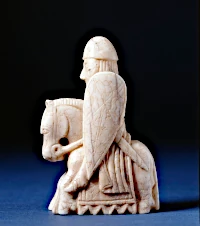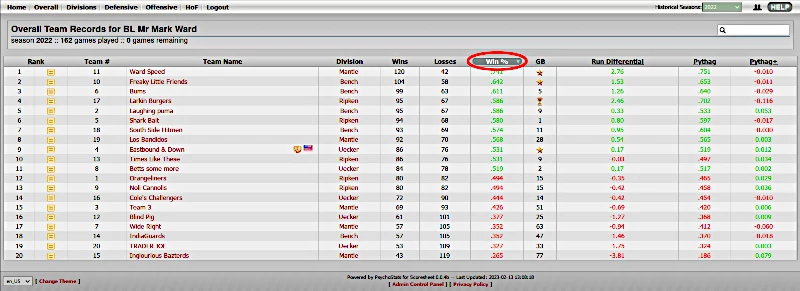Help Entries
HINT: Try to include specific words or acronyms that you think might be included in the help entry you are trying to find. For example, if you want to know how the DRAT rating is calculated, just enter "DRAT".

Scoresheet Trading Scams
Scoresheet waters are full of sharks. Your best defence against scammers is to understand the tactics and strategies that they use. Typical Scoresheet scams involve some combination of getting another player to accept a trade on the basis of inflated or dimished asset values. What follows is a list of some of the more common Scoresheet trading scams.
- Hospice Scam: In this scam the owner trades an injured player to another owner who is unaware of the injury status of the player involved. This is perhaps the oldest scam in the book, and one that has a good chance of ending up with an officially reversed trade. Always, always, always check up on the injury status of players involved in a trade before you make a trade, including players you are trading. A fast way to check injury status is to do a search for "cbs fantasy news [player name]"
- Evil Twin Scam: This is a scam where an owner switches the target player of the opposing owner with another player with the same name. This is one of the dirtiest trading tricks in the game and will absolutely result in a reversed trade when caught. Always, always, always double and triple check trades before you confirm them. Make sure player names match, and player numbers match.
- Matching Round Scam: This is a scam where an owner switches a later pick in a round for an earlier pick, where that owner has multiple picks to trade from the same round. As is the case with many "scams", it isn't always intentional, accidents do happen. Always, always, always, double and triple check to make sure that, not only are you receiving your desired pick, but you are actually trading the pick you intended to trade.
- Bullshit Baffles Brains/Kitchen Sink Scam: This is a scam where an owner attempts to trade many low value players for one high value player. "I threw everything, including the kitchen sink, at that trade!"
- Hot Catcher Scam: Where an owner attempts to trade a catcher who is on a hot hitting streak, but is unlikely to keep hitting that way. It isn't always a catcher, but often it is. Everyone needs catchers, and catchers tend to run hot and cold, moreso than other positions, in part because catcher is one of the most physically and mentally demanding positions to play, and as a corollary to that, they don't get as many regular at bats as other hitters.
- Hot Baby Scam: This is a variation on the "Hot Catcher Scam". It's cagey and requires smart scouting and an in depth understanding of what is happening in MLB's minor leagues. In this case Sir Shark drafts a number of minor leaguers that are not super high end prospects, solid but unspectacular. Hitters don't just get hot in the majors, they do that in the minors as well. Sir Shark waits for his minor leaguers to get hot, and attract some buzz, then trades them while their value is high. The key to this scam, and what makes it a scam, is that the perpetrator doesn't expect the hot streak to last, and Sir Shark is usually right.
- Fading Star Scam: Where an owner attempts to get another owner to overpay for a former star who is in a funk that appears likely to last for the rest of his career.
- One Foot in the Grave/Retirement Scam: Similar to the "Fading Star Scam" this is where an owner attempts to get another player to overpay for a star player whose days of meaningful contribution are over and who is on the verge of retiring. Hey, we all have our favourite players!
- "And One" Draft Pick Scam: It goes something like this, "Sure we can make that trade, but I can't do that trade straight up. I'll need a little something extra to make it work..." Just throw in that rd 30, or rd 35... Meanwhile that low round draft pick allows Sir Shark to protect yet another hot prospect who will probably be worth more than any of the other players involved in that trade.
- Prospect Capital Scams: In a lot of leagues in Scoresheet "hot prospects" are treated like currency. They are probably years away from being productive major league players, and they are one of the most overvalued assets in the game.
- Amateur Draft Round Scams: In most leagues in Scoresheet the supplemental rounds where the players from that season's MLB amateur draft first become available are considered to be among the most valuable draft picks of the season. It is common for veteran owners to prey on less experienced owners and "acquire" those picks for far less than their accepted value. "Supp picks aren't worth much, but I'll help you out..."
- Undervalued Draft Pick Scams: When you trade a pick for a player, it is a multi-asset trade. You are trading that pick, and getting a player in return presumably for the current season, if you trade away the pick during the off season, the deal becomes even more unbalanced. You are trading away the player you would have picked for that player. If you end up protecting that player, you are also trading away the player you would have protected in that player's place. Not only that, but you are going to be down a player for the entire next season.
If it's a late round pick it may appear that that pick doesn't have much value, although useful, productive players are always available, so there is no such thing as a draft pick that has no value. But more importantly, late round draft picks are used to protect minor league prospects, which can have a great deal of value. So that rd 30 - 35 "throw in" can afford the owner who receives it a great deal of value, and should not be offered lightly.

Winning Trades
There are two ways to acquire players in Scoresheet, one is through trades and one is through the draft. Drafting well is the absolute bedrock for building a winning team, but trading well can put your team over the top. So how do you "win" trades in Scoresheet Baseball?
Let's start with the word "win". One of the most common mistakes made when approaching trades is the idea that you need to "win" every trade that you make. Scoresheet is a game with a very long "play arc" and the wisest and craftiest owners play the game as it if were chess, always trying to think several moves ahead of every other owner in their league.
There are some who say that the team that gets the best player in a trade, has "won" the trade. That's a good basis to start on, but that idea does not even begin to capture the subtleties of making trades in a Scoresheet league. One thing you do not want to do is make a trade where the result is that the other owner never wants to make another trade with you.
Trading in Scoresheet is a psychological and social game as well as a strategic game. You want to trade, as much as possible, from strength to weakness. In other words you want to trade from a surplus your team may have, to shore up a deficit your team may have. Sometimes it is also a good idea to allow another player to "win" a trade with you.
Good will and friendship are a great foundation to build future trades on.

How do I sort tables in PsychoStats?
Just click on the column header in any table, and it will sort the table based on the contents of that column. If you click it again, it will reverse the sort.
A few columns cannot be sorted. The headers of those columns don't display as links. The Division column in the Overall Team Records page is an example of one such column.
RA
Runs Against
This is the total runs against, including unearned runs, per 9 innings. For the purposes of PsychoStats RA is considered to be a more meaningful team statistic than ERA, due to the fact that it includes the consequences of fielding errors.
Formula:
[Total Runs Scored Against] / [Innings Pitched] * 9
OPS
On Base Plus Slugging
Standard baseball statistic that has become the gold standard for measuring a hitter's offensive output, On Base Average added to Slugging Average.
This is the basis for the hitter "V" rating on the team rosters pages.
DRAT
Team Defensive Rating
Scoresheet Baseball games are a statistical baseball simulation, but they are not baseball itself. As such Scoresheet Baseball games generate their own unique statistics. One of the biggest challenges in real life baseball statistics is generating actionable data from defensive performances. Thankfully in the Scoresheet Baseball simulation, this is a bit easier because team defence is reduced to numbers.
DRAT is an attempt to generate a team defensive rating based on the defensive data generated by the Scoresheet Baseball simulation. It combines all the defensive stats into a single number. The meta objective of DRAT is to achieve a number that accurately reflects the number of defensive runs saved by team defence per nine innings. This has not been tested, and will likely never be, so what we are left with is an educated guess, and probably a not terribly accurate one. However the final number generated is useful for comparison purposes.
Formula (all stats in the formula are team total stats):
( ( [Outstanding Plays] - [Fielding Errors] - [Passed Balls] ) / ( [Innings Pitched] - [Strikeouts] * 0.33 ) + [Double Plays Turned] / ( [Hits Allowed] + [Walks Allowed] ) * 0.5 + [Opponent Base Runners Caught Stealing] / ( [Opponent Stolen Bases] + [Opponent Base Runners Caught Stealing] ) * 0.05 ) * 3
SRAT
Team Speed Rating
Scoresheet Baseball games are a statistical baseball simulation, but they are not baseball itself. As such Scoresheet Baseball games generate their own unique statistics. One of the biggest challenges in both real life and Scoresheet baseball statistics is generating actionable data from offensive numbers impacted by team speed.
SRAT is an attempt to generate a team offensive speed rating. It combines all the offensive stats affected by team speed into a single number. The meta objective of SRAT is to achieve a number that accurately reflects the number of runs scored impacted by team speed per nine innings. This has not been tested, and will likely never be, so what we are left with is an educated guess, and probably a not terribly accurate one. However the final number generated is useful for comparison purposes.
Formula (all stats in the formula are team total stats):
( ( ( [Stolen Bases] - [Caught Stealing] ) * 3 + [Triples] * 6 + [Run Support] - [Grounded into Double Plays] / 1.5 - [Home Runs] * 1.5 ) / ( [Hits] + [Walks] - [Home Runs] ) * 10 + 10 ) * 0.05
ERA
Earned Run Average
One of the most oldest and well used baseball statistics in the history of the sport. It represents the number of earned runs scored against a pitcher per 9 innings pitched. Runs scored as a result of fielding errors and passed balls do not count toward a pitcher's ERA, while runs scored as a result of wild pitches do. If a pitcher leaves a game the runners already on base will count toward the pitcher's ERA if they score.
In Scoresheet ERA is the single most important pitcher statistic. The Scoresheet game simulation does a very good job of recreating the pitcher's real life ERA, modified of course by the total team range rating.
TERA
Total Earned Runs Against
Total earned runs scored against the given team.
Player Range
Player ranges are among the most complex elements of the Scoresheet game sim mechanics. Player ranges determine how many Outstanding Plays your team will generate, as well as how many Double Plays your team will turn. Half of the range rating of infielders is a standard Scoresheet range rating, and half is a double play rating. Players playing CF have their range rating doubled.
OP
Outstanding Plays
This is a team stat, as well as an individual player stat. It is a Scoresheet specific stat generated by total team range ratings. When there is a chance of an Outstanding Play the simulation first checks the total team range rating, then if an outstanding play is generated, it is awarded randomly based on the individual player ratings.
See Player Range and DP/Double Plays for more information.
wOBA
Weighted On Base Average
From MLB.com
"wOBA is a version of on-base percentage that accounts for how a player reached base -- instead of simply considering whether a player reached base. The value for each method of reaching base is determined by how much that event is worth in relation to projected runs scored (example: a double is worth more than a single)."
In PsychoStats wOBA is both a team average statistic, and an individual player statistic. In PsychoStats wOBA does not include data for intentional walks and hit by pitch.
Formula:
( 0.69 * [Walks] + 0.89 * [Hits] - [Doubles] - [Triples] - [Home Runs] ) + 1.27 * [Doubles] + 1.62 * [Triples] + 2.10 * [Home Runs] ) / [At Bats] + [Walks] + [Sacrifice Flies] )